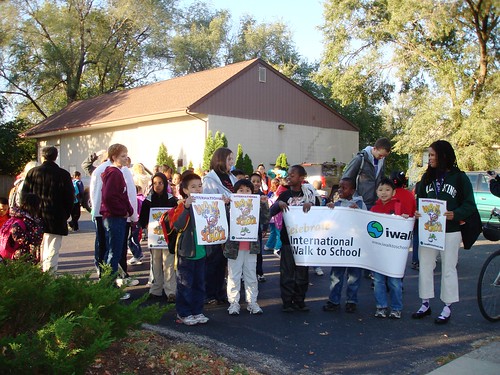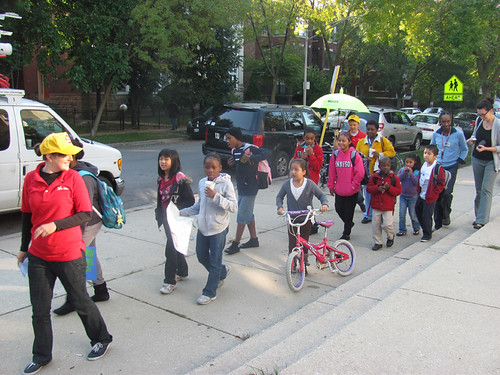
Illinois students celebrate National Walk and Bike to School Day. Photo: Champaign-Urbana MTD
As autumn turns to winter, parents across Illinois hustle through the sleepy, pre-dawn period to bundle up children and get them ready for school. By this time of the year, the rhythm has become engrained. However, the daily task of commuting to school is about to get a makeover thanks to a new round of funding for the Illinois Department of Transportation’s Safe Routes to School program.
Since it launched in the U.S. in the mid-1990s, the SRTS movement, whose goal is to help more kids walk and bike to school safely, has already improved many Illinois communities. It was the key agenda item Wednesday at a meeting hosted by the Active Transportation Alliance in west suburban Elmhurst, attended by reps from the cities of Lombard, Elk Grove Village, and Bartlett, as well as the League of Illinois Bicyclists and Friends of Cycling in Elk Grove. “Safe Routes impacts the community more broadly by focusing on this microcosm – the route to school,” said Melody Geraci, deputy director of Active Trans.
The money for the latest round of SRTS funding, from the latest federal transportation bill, MAP-21, totals five million dollars for infrastructure projects and one million dollars for education projects, and is available for IDOT to administer throughout the state. These federal grants require a 20 percent local match, which must be provided by the applicant.
Municipalities, counties, townships, or park districts can apply for up to $200,000 for infrastructure projects. IDOT has listed a wide range of street design treatments for applicants to choose from, giving Geraci hope that, “[The variety of treatments] will prompt applicants to think of something different.” She and Ed Barsotti, director of the LIB, said these projects, which include items like sidewalk upgrades, crosswalks, flashing beacons, bikeways, and parking racks, are inexpensive but can have a big impact. Many of the western suburban representatives present at the meeting were already planning to apply for the funding or had done so in the past.
A "walking school bus" makes it safer and more fun to walk to school. Photo: CDOT
School districts can apply for funding for non-infrastructure programs. These center on the “five Es”: engineering, education, encouragement, enforcement, and evaluation. Because strong relationships with schools are key to the programs’ success, the meeting participants shared best practices and stressed the importance of building positive and sustainable relationships with parents, teachers and administrators.
For example, since school staffers will lead the programs, one idea to gain the schools’ continued buy-in is to couple Safe Routes with the schools’ existing healthy living programs. Carl Goldsmith, Lombard’s director of public works, emphasized, “A lot depends on your relationship with a school and how you approach it as a community.” That makes sense, because Safe Route’s goal is create better connections between schools and the communities they serve.
Applications are due by January 31. Since IDOT will announce qualifying municipalities and schools this summer, applicants should have enough time to allocate the matching funds for the next budget year and get their communities excited about the changes ahead. Get more information about the program and download the RFPs here.





